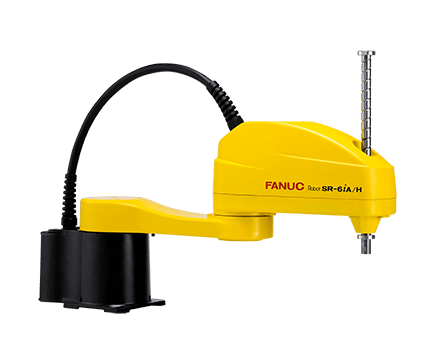What can SCARA Robots be used for?
SCARA robots are one of the main types of industrial robots. SCARA stands for Selective Compliance Articulated Robot Arm. Most SCARA robots feature compact footprints with light payloads and short reaches. They operate in a cylindrical work envelope with the ability to move along the X, Y, and Z planes. Most SCARA’s are configured with four axes. The X and Y axes of SCARA’s are dynamic allowing for flexible movements while the Z axis is fixed or rigid, giving them “selective compliance.”SCARA robots are ideal for automating processes involving small or light parts. Their selective compliance and axis configuration make them perfect for fast-paced applications along with those requiring precision. The FANUC SR-6ia along with other SCARA robots are some of the fastest in the industry. With only four axes, there are fewer moving joints simplifying kinematic calculations and allowing for greater operational speeds.
SCARA robots are typically used to automate highly repetitive and simple applications. Processes involving moving parts from one point to another are best for SCARA robots as these typically fall in line with their X, Y, and Z movements. SCARA robots have been implemented in a variety of industries including the automotive and electronics industries. The main types of applications they can automate include:
- • Assembly - When SCARA robots were initially released in 1978, they were used exclusively for assembly automation. Their name originally stood for Selective Compliance Assembly Robot Arm but was later changed when they began automating other types of applications. The combination of flexible and fixed axes makes them ideal for automating small parts assemblies. The FANUC SR-3ia can automate tasks such as inserting pegs or driving screws to secure or attach parts. SCARA robots have some of the best repeatabilities of all robot types. Errors are nearly eliminated with the rigid Z axis which prevents the robot from pivoting. Repeatability is crucial for small parts assemblies as tolerances need to be within several microns. SCARA robots have tolerances under 10 microns while six-axis robots are usually around 20 microns.
- • Pick and Place - SCARA robots are ideal for automating pick and place applications. Their speed can significantly reduce cycle times. They can quickly move parts from point A to point B.
- • 3D Printing - 3D printing is one of the newer applications being automated by robots. The FANUC M-20ia along with other articulated robots have been used for the 3D printing of large objects. However, for small 3D printing jobs SCARA robots are being utilized.
- • Dispensing - SCARA robots can be used in two ways to automate dispensing applications. They can select workpieces and place them in front of a dispensing machine, or they can be integrated with a dispensing tool.
- • Others - SCARA robots can also be used to automate packaging, inspection, and light palletizing tasks. For packaging and palletizing a SCARA robot can be integrated with a gripper. Since these applications typically involve straightforward and repetitive movements, SCARA robots are ideal for automating them. Inspection applications will involve integrating a SCARA robot with a vision system. SCARA robots with vision can thoroughly inspect parts with the ability to detect small defects, improving quality control measures.
Robots Done Right is the place to start when it comes to used robots. Contact us if you are interested in buying or selling a used robot.
